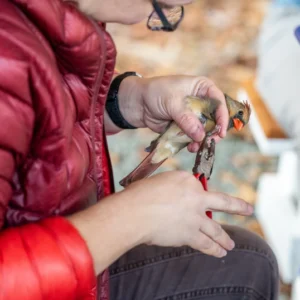Nesting Materials for Backyard Birds
Seeing birds in their backyards is an essential part of the spring and summer seasons for many Canadians. After the long and dreary winter months, catching a sight of a flying robin is enough to announce that spring is finally here. Not to mention the excitement that many Canadians feel when they see migratory birds making it back to Canadian soil after spending the winter months in the southern regions.
For many birders and naturalists, an opportunity to act as stewards for our aerial neighbours is too good to pass by. Thus, one of the most common and most popular acts of stewardship is to provide breeding habitat and nesting materials for Canada’s backyard birds.
For decades, it was a common occurrence in many suburban/rural backyards to have a variety of nesting materials hanging in mesh bags or in suet cages. Materials ranged from items naturally found in a bird’s environment such as mud, dried grass, twigs and sticks, leaves and pine needles to human provided materials such as shredded paper, yarn and pet hair.
Recently, the concept of providing materials like yarn and hair has become a controversial topic. Many birders are worried that yarn, threads, hair or twine could potentially injure, or even kill birds and their nestlings if the material tangles around their appendages. While that is a possibility, the Canadian Wildlife Federation suggests that yarn, thread and strings are useful nesting materials for birds, provided they aren’t too long. Keeping them between 3-6 inches should be an appropriate size, as any shorter sizes aren’t considered attractive by the birds and any longer could pose a threat. If you decide to put out yarn, always make sure that it is made of natural fibers only without any chemical additives.
It is also common to provide animal fur that has come from household pets. It is a very popular material with birds as it provides soft lining for the nests that provides insulation to its inhabitants. While animal fur in itself won’t damage the birds, any fur from pets that have been treated with chemicals (flea control/ repellents) is extremely dangerous to the health of the nestlings. Long strands of human hair should also be avoided as usually it is long, thin and can easily get caught around a bird and cut of its circulation.
Birds are hardy creatures and will often build their nests out of any materials they find nearby. Providing easily accessible materials can make their lives much easier during the hectic breeding season, however, our good intentions can quite often be muddied if we provide materials that do more harm than good. Plastic materials and materials that have been treated with chemicals should be avoided with extreme prejudice. Nestlings are extremely vulnerable to the smallest levels of toxicity in their nests and will often fail to survive in the presence of toxic materials.
We have provided a list of acceptable nesting materials to place in your backyards during the early nesting season. It is important to remember that providing nesting materials is the most useful to birds during the late spring and early summer months. The availability of food and clean water also determines if the birds in your backyard will actually nest on your property.
Nest Building Materials:
- Mud, pebbles & small rocks
- Dried grass & leaf litter
- Pine needles, twigs, sticks & branches
- Thread, fabric, twine & yarn (3-6 inches)
- Animal fur (no chemicals)
- Shredded paper
- Feathers



